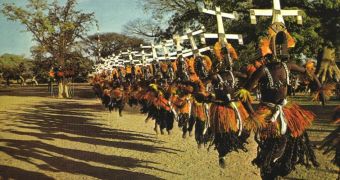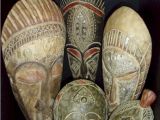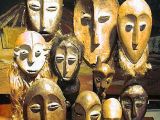In an African forest, a man heads to a tree bearing an ax. He has to accomplish a religious mission, done in Africa countless times along the millennia. Inside the tree lives a deeply respected spirit. To be protected against its rage, the man has first visited a wizard. Than he underwent a purification ceremony and made a sacrifice for the spirit of the tree.
After the first blow, the sticks his lips of the cut, sucking a little sap for getting related with the tree. After cutting down the tree, the man leave it there for several days, to allow the spirit find another dwelling. The tree still has a miraculous power even after the spirit is gone, so that he has to follow specific rites.
In the skilled hands of the carver, the wood takes the shape of a mask. It is believed that while the mask is getting shape, wood's powers are increasing. The carver cannot make freely whatever shape he wants; the representation must be typical for his ethnic group. If not, he will receive the disapproval of his community and the rage of the spirit of the mask.
The wizard can make now a consecration ceremony and the mask turns into the dwelling of the spirit to which is dedicated. Now it can be used in religious ceremonies.
The mask can be used as fetish, in the case of miniature ones, or worn, in this case invoking the forebears, spirits or supernatural beings. They represent natural spirits or those of the dead. Lacking expression or frightening, misshapen or abstract, they warn about the power of the dead and the believe that death is not the end.
The masks are also important as protection against witchery, in initiation ceremonies, festivities, trials, and fertility rites. In the African synchretism, masks are also present in Christian ceremonies. In Sierra Leone, the masked "devils" approach dancing to the church courtyard to present their greetings.
From about 1,000 ethnic African groups, about 100 use masks. Amongst groups, masks vary in shape, linked to their goal. Those representing the spirits of the forebears have a serene look, while those representing non-human spirits have a bizarre face. High, round front depicts wisdom and profound spirituality. Protuberant eyes and cold expression means the stage of being possessed by the spirits. White coloring suggests the spirits of the dead, as they look on the other world. Masks with horns, like antelope or African buffalo, are linked to exorcism ceremonies, spirit transmigration and witchery.
A mask can cover the face or the whole body, the rest of the body being covered by long robes, or long stretches of raffia or woody plant fibers. The wearer is considered to be in direct connection with the mask's spirit. It enters into a trance and turns into an skilled "partner" of the acted character. It is under the control of the mask, losing identity and own will.
The allowed spectators are almost always only men and it is considered that a supernatural living person is represented by the mask. The mask is sacred, and violating the rules of its use is harshly punished by the community, even with death.
Western collectors consider the masks as art items, appreciated for their simplicity, vitality, and profundity of the comprised feelings. In fact, sculptors make extremely different masks for religious goals and touristic trade, which can be technically better made but artistically inferior.
Masks representing in religious dances beneficial or malefic forces, sacred or holy, are also employed in the Buddhist monasteries of Nepal, Tibet or Japan, but also in many primitive tribal societies. They are generally worshiped like the statues. Their role in the religious and social life of our forebears can be as old as the age of the human species.

 14 DAY TRIAL //
14 DAY TRIAL // 

